Corundum
Corundum has historically been used as an abrasive, but it is most famous as the mineral of ruby and sapphire.
Article by: Hobart M. King, PhD
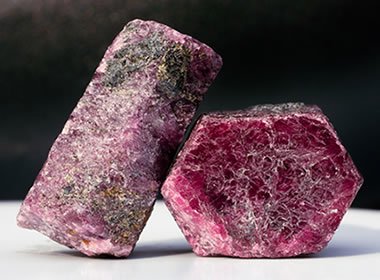
Corundum: Two corundum crystal segments from India showing the mineral's six-sided crystals with basal parting. These specimens are red in color and might be called "ruby corundum." Image copyright iStockphoto / Lissart.
What is Corundum?
Corundum is a rock-forming mineral that is found in igneous, metamorphic, and sedimentary rocks. It is an aluminum oxide with a chemical composition of Al2O3 and a member of the trigonal crystal system.
The mineral is widely known for its extreme hardness and for the fact that it is sometimes found as beautiful transparent crystals in many different colors. The extreme hardness makes corundum an excellent abrasive, and when that hardness is found in beautiful crystals, you have the perfect material for cutting gemstones.
Natural and synthetic corundum are used in a wide variety of industrial applications because of their toughness, hardness, and chemical stability. They are used to make industrial bearings, scratch-resistant windows for electronic instruments, wafers for circuit boards, and many other products.
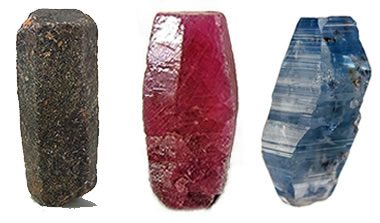
Corundum crystals: Photos of three corundum crystals. On the left is a common corundum from Transvaal, South Africa, that is about 6 centimeters in height. In the center is a gem-quality ruby corundum from Karnataka, India, that is about 1.6 centimeters in height. On the right is a blue sapphire corundum from Sri Lanka that is about two centimeters in height. All three specimens and photos by Arkenstone / www.iRocks.com.
Made Famous by Rubies and Sapphires
Most people are familiar with corundum; however, very few people know it by its mineral name - instead they know it by the names "ruby" and "sapphire." A gemstone-quality specimen of corundum with a deep red color is known as a "ruby." A gemstone-quality corundum with a blue color is called a "sapphire." Colorless corundum is known as "white sapphire." Corundum of any other color is known as "fancy sapphire."
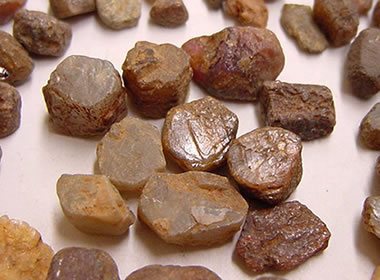
Corundum parting: Six-sided crystal segments of corundum that have been separated by parting. These specimens are about one centimeter across. USGS photo by Andrew Silver.

Corundum gneiss with sapphire: A specimen of corundum gneiss from Gallatin Valley, Montana. This specimen is about twelve centimeters across and has a round blue sapphire crystal on the left side.
Properties of Corundum
Corundum is an exceptionally hard and tough material. It is the third-hardest mineral, after diamond and moissanite. It serves as the index mineral for a hardness of nine on the Mohs Hardness Scale.
Its hardness, high specific gravity, six-sided crystals and parting are very good diagnostic properties to use in its identification. A summary of the physical properties of corundum is given in the table below.
Physical Properties of Corundum |
|
| Chemical Classification | Oxide |
| Color | Typically gray to brown. Colorless when pure, but trace amounts of various metals produce almost any color. Chromium produces red (ruby) and combinations of iron and titanium produce blue (sapphire). |
| Streak | Colorless (harder than the streak plate) |
| Luster | Adamantine to vitreous |
| Diaphaneity | Transparent to translucent |
| Cleavage | None. Corundum does display parting perpendicular to the c-axis. |
| Mohs Hardness | 9 |
| Specific Gravity | 3.9 to 4.1 (very high for a nonmetallic mineral) |
| Diagnostic Properties | Hardness, high specific gravity, six-sided crystals sometimes tapering to a pyramid, parting, luster, conchoidal fracture |
| Chemical Composition | Al2O3 |
| Crystal System | Trigonal |
| Uses | Historically used as an abrasive. Specimens with pleasing colors have a long history of gemstone use. |
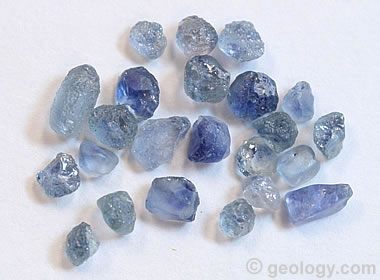
Montana alluvial sapphires: A scatter of small alluvial sapphires found in Montana. These blue stones are untreated and measure about four to five millimeters across.
Geologic Occurrence of Corundum
Corundum is found as a primary mineral in igneous rocks such as syenite, nepheline syenite, and pegmatite. Some of the world's most important ruby and sapphire deposits are found where the gems have weathered from basalt flows and are now found in the downslope soils and sediments.
Corundum is also found in metamorphic rocks in locations where aluminous shales or bauxites have been exposed to contact metamorphism. Schist, gneiss, and marble produced by regional metamorphism will sometimes contain corundum. Some of the sapphires and rubies of highest quality, color, and clarity are formed in marble along the edges of subsurface magma bodies.
Corundum's toughness, high hardness, and chemical resistance enable it to persist in sediments long after other minerals have been destroyed. This is why it is often found concentrated in alluvial deposits.
These deposits are the most important source of rubies and sapphires in several parts of the world. Traditional sources of alluvial rubies and sapphires include Burma, Cambodia, Sri Lanka, India, Afghanistan, Montana, and other areas. In the past few decades, several parts of Africa, including Madagascar, Kenya, Tanzania, Nigeria, and Malawi, have become important producers of ruby and sapphire.
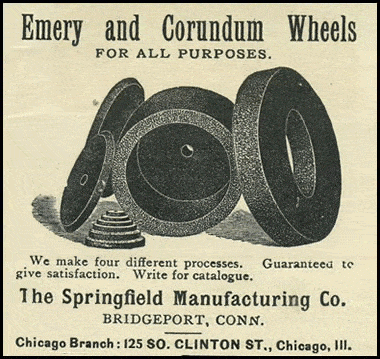
Emery wheels: An ad offering emery and corundum wheels, published in 1895 by The Springfield Manufacturing Company of Bridgeport, Connecticut. This was at a time when genuine emery and corundum were used to make the wheels.
Hardness and Use as an Abrasive
The extreme hardness of corundum makes it especially useful as an abrasive. Crushed corundum is processed to remove impurities and then screened to produce uniformly sized granules and powders. These are used for grinding media, polishing compounds, sand papers, grinding wheels, and other cutting applications.
Some problems with using natural corundum as an abrasive are that the deposits are usually small, irregular in shape, and the corundum is of variable quality. They are not reliable sources of consistent-quality material needed to run a manufacturing process. Synthetic corundum, produced using calcined bauxite, has become a more reliable source with more consistent properties. It has replaced natural corundum in most manufactured products.
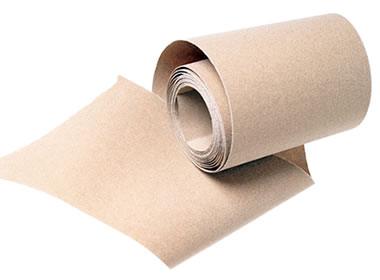
Aluminum oxide sandpaper is made by attaching size-graded particles of synthetic corundum (aluminum oxide) to a sheet of paper. It is a sandpaper widely used for woodworking and other manufacturing work. Photo copyright iStockphoto / Ma-Ke.

Emery rock: A specimen of emery rock that is rich in corundum and spinel from Peekskill, New York. This specimen is approximately six inches (fifteen centimeters) across. Emery has often been crushed, processed, and screened for use as an industrial abrasive.

Emery nail files: "Emery boards" are a manicure and nail-care product that is made by gluing abrasive papers to a thin piece of cardboard. They obtained their name in the 1800s when crushed emery was used as the abrasive. Today's emery boards are not made with emery. Instead, many of them have a coarse side of synthetic corundum (aluminum oxide) and a fine side of garnet abrasive. Photo copyright iStockphoto / Acerebel.
Emery
Emery stone is a granular metamorphic or igneous rock that is rich in corundum. It is a mixture of oxide minerals, typically corundum, magnetite, spinel and/or hematite. It is the most common form of natural corundum that has been used to manufacture abrasives.
The use of emery as an abrasive has declined significantly in the last several decades. It has been almost completely replaced by manufactured abrasives such as silicon carbide. Silicon carbide has a Mohs hardness of 9 to 9.5. It is inexpensive and usually performs better than natural abrasives made from corundum or emery.

Corundum as ruby, sapphire, and fancy sapphire: Gem-quality corundum is a highly prized and valuable material. When it is bright red in color it is called "ruby." When it is blue it is called "sapphire." When colorless it is called a "white sapphire." Gem-quality corundum of any other color is called "fancy sapphire." In the past, most gem corundum was produced in Asia and Australia. In the 1990s, many gem corundum discoveries were made in Africa. All of the stones in this photo were mined in Africa. Nearly all gem corundums are treated by heating or another process to improve their color.

The best way to learn about minerals is to study with a collection of small specimens that you can handle, examine, and observe their properties. Inexpensive mineral collections are available in the Geology.com Store. Image copyright iStockphoto / Anna Usova.
Use as a Gemstone
In the gemstone and jewelry market, almost all of the attention goes to a small group of gems known as "the big four": diamond, ruby, sapphire, and emerald. Two of these, ruby and sapphire, are gem corundums.
These most popular gems are highly sought after and have been mined in many parts of the world for thousands of years. Today, millions of rubies and sapphires are required every year to meet the demands of the jewelry market -- from inexpensive commercial stones sold in malls and department stores to spectacular specimens used in designer and custom jewelry. The demand for attractive stones exceeds the abilities of mines to supply. As a result, the prices paid for attractive natural stones have risen to high levels.
When a consumer wants a "ruby ring" or a "sapphire pendant," they are generally not interested in substituting a red spinel, blue iolite, or other attractive gem of similar color. They want "ruby" or they want "sapphire." Retail jewelers, especially those selling pieces and sets for under $500, have been increasingly presenting synthetic or "lab-created" gems alongside the natural stones in their display cases.
The synthetic materials have the same aluminum oxide composition and crystal structure as natural rubies and sapphires. Their color is also produced by the same trace elements (chromium for ruby and iron with titanium for sapphire).
They have the same optical appeal and usually a better physical appearance than similar-size natural stones of the same price. As a result, many consumers now gladly purchase synthetic stones because they receive a more attractive product at a price that they can afford. Over the long term, synthetic gems are likely to continue displacing natural stones from the market, especially in the lower and middle price ranges where consumers are very conscious about price.
There is nothing wrong with selling or purchasing jewelry that contains synthetic gemstones as long as two conditions are met: 1) the seller must disclose the fact that the gemstones are products of man rather than products of nature; and, 2) the buyer clearly understands that the gemstones are synthetic and made by people rather than being products of nature.
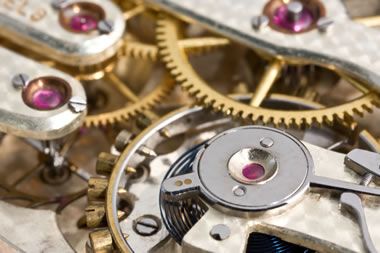
Corundum watch bearings: Corundum (ruby) bearings in an antique pocket watch with a "jewel" movement. In the early 1900's, synthetic corundum was being used as the jewel bearings in watches. Image copyright iStockphoto / RobertKacpura.
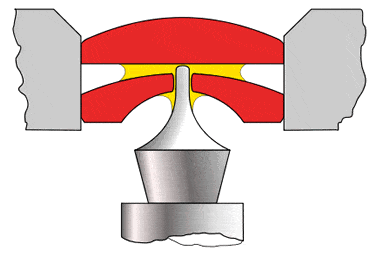
Corundum bearings: A drawing of jewel bearings and a capstone (red) holding a pivot wheel in a mechanical watch lubricated by oil (yellow). Public domain image by Chris Burks Chetvorno.
"Jewels" and "Crystals" in Watches
In the mid-1800s, watch makers in Switzerland needed tiny bearings that were highly resistant to abrasion. They discovered that they could drill a hole into a tiny piece of corundum and use it for a smooth-running, long-life bearing. The corundum was much harder than the metals used to make the moving parts of a watch, and it was able to stand up to the continuous abrasion without failing. The corundum bearings were called "jewel bearings" after their gemstone counterparts.
Swiss watches and their "jewel movements" became famous throughout the world for their long life and reliability. In the early 1900s, synthetic corundum bearings replaced natural corundum bearings in most Swiss watches. Synthetic corundum was more uniform than natural corundum as well as being cheaper and easier to obtain. This use of jewel bearings created a positive reputation for Swiss watches that continues to this day - even while mechanical watches are being replaced by digital watches.
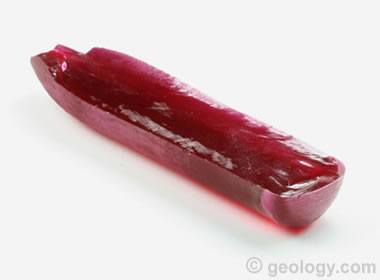
Synthetic corundum: A boule of synthetic corundum. Because of its red color, it could be called "synthetic ruby." Material like this is used for watch bearings, gemstones, laser gain mediums, and many other purposes.
Colorless synthetic sapphire is also used in watches. Its durability, vitreous luster, and resistance to being scratched makes it a perfect transparent covering for the face of a mechanical or digital. These clear covers, known as "crystals" protect the face of the watch from impact, dust, moisture and abrasion. Synthetic sapphire has been used for this purpose for nearly 100 years.
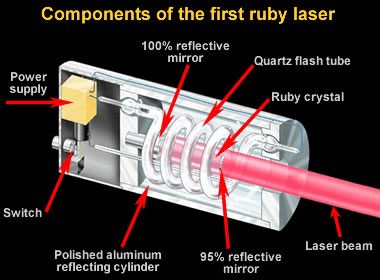
Ruby laser: Diagram of the first working laser. It employed a thin ruby crystal as its gain medium. Public domain image by Lawrence Livermore National Laboratory.
Ruby Lasers
Synthetic corundum is an essential part of many lasers. In fact, the first working laser was a "ruby laser," made by Theodore Maiman at Hughes Research Labs in 1960. It employed a synthetic ruby crystal as the "gain medium." The gain medium is a material in the laser that is the target of an intense burst of light.
That light causes electrons in the gain medium to jump up to a higher energy level causing the emission of photons, which strike other atoms in the gain medium, causing them to be excited and emit more photons. This brief chain reaction produces the very intense light of a laser beam. Lasers are named after the material used as a gain medium, such as "ruby laser" or "titanium sapphire laser" or "YAG laser" (yttrium aluminum garnet).
In just a few decades, lasers have become common items of our society. Tiny lasers are used in CD and DVD players. Lasers are used to cut metal, stone, and other tough materials. Lasers are used to remove tattoos, perform cosmetic surgery, cataract surgery, and LASIK surgery for vision correction.

Synthetic corundum scanner windows: A self-check-out machine with a barcode scanner window at a retail store in Houston, Texas. The window of the scanner is probably made from synthetic corundum. Public domain image by WhisperToMe.
Other Uses of Corundum
Corundum has many other uses. It is chemically inert and resistant to heat. These properties make it a perfect material for making refractory products such as fire brick, kiln liners, and kiln furniture. Today, these products are usually made with synthetic corundum.
Pure corundum is colorless, transparent, durable, and scratch resistant. Large crystals of clear synthetic corundum are grown, sawn into thin sheets, and then used as the windows of grocery store scanners, watch crystals, aircraft windows, and protective covers for electronic devices.
| More Minerals |
 |
Herkimer Diamonds |
 |
The Acid Test |
 |
Tumbled Stones |
 |
Zircon |
 |
Fool*s Gold |
 |
Kyanite |
 |
Rock Tumblers |
 |
Rhodochrosite |

Find Other Topics on Geology.com:

|

| ||

|

| ||

|

| ||

|

|
